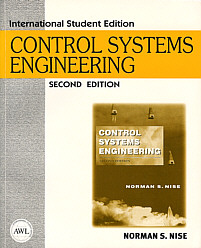Misją Instytutu jest dzialalność naukowo-badawcza prowadząca do nowych rozwiązań technicznych i organizacyjnych użytecznych w kształtowaniu warunków pracy zgodnych z zasadami bezpieczeństwa pracy i ergonomii oraz ustalanie podstaw naukowych do właściwego ukierunkowywania polityki społeczno-ekonomicznej państwa w tym zakresie.

Addison Wesley Longman Inc., second edition, 1995
|
| 1. Introduction (1) |
| 1.1. Introduction (2) |
| 1.2. A History of Control Systems (4) |
| 1.3. The Control Systems Engineer (9) |
| 1.4. Response Characteristics and System Configurations (10) |
| 1.5. Analysis and Design Objectives (14) |
| Antenna Azimuth: An Introduction to Position Control Systems (17) |
| 1.6. The design Process (21) |
| 1.7. Computer-Aided Design (27) |
| Summary (28) |
| Review Questions (28) |
| Problems (29) |
| Bibliography (33) |
| 2. Modeling in the Frequency Domain (35) |
| 2.1. Introduction (36) |
| 2.2. Laplace Transform Review (37) |
| 2.3. The Transfer Function (46) |
| 2.4. Electric Network Transfer Functions (49) |
| 2.5. Translation Mechanical System Transfer Functions (64) |
| 2.6. Rotational Mechanical System Transfer Functions (71) |
| 2.7. Transfer Functions for Systems with Gears (76) |
| 2.8. Electromechanical System Transfer Functions (81) |
| 2.9. Electric Circuit Analogs (87) |
| 2.10. Nonlinearites (91) |
| 2.11. Linearization (92) |
| Antenna Control: Transfer Functions (98) |
| Transfer Function of a Human Leg (100) |
| Summary (102) |
| Review Questions (102) |
| Problems (103) |
| Bibliography (115) |
| 3. Modeling in the Time Domain (117) |
| 3.1. Introduction (118) |
| 3.2. Some Observations (119) |
| 3.3. The General State-Space Representation (124) |
| 3.4. Applying the State-Space Representation (126) |
| 3.5. Converting a Transfer Function to State Space (133) |
| 3.6. Converting from State Space to a Transfer Function (140) |
| 3.7. Linearization (141) |
| Antenna Control: State-Space Representation (144) |
| Pharmaceutical Drug Absorption (146) |
| Summary (149) |
| Review Questions (150) |
| Problems (150) |
| Bibliography (158) |
| 4. Time Response (159) |
| 4.1. Introduction (160) |
| 4.2. Poles, Zeros, and System Response (161) |
| 4.3. First-Order Systems (164) |
| 4.4. Second-Order Systems: Introduction (167) |
| 4.5. The General Second-Order System (172) |
| 4.6. Underdamped second-Order Systems (176) |
| 4.7. System Response with Additional Poles (186) |
| 4.8. System Response with Zeros (190) |
| 4.9. Laplace Transform Solution of State Equations (915) |
| 4.10. Time Domain Solution of State Equations (198) |
| 4.11. Time Response via Computer Simulation (203) |
| Antenna Control: Open-Loop Response (206) |
| UFSS: Open-Loop Pitch Response (209) |
| Summary (212) |
| Review Questions (214) |
| Problems (215) |
| Design Problems (223) |
| Bibliography (225) |
| 5. Reduction of Multiple Subsystems (226) |
| 5.1. Introduction (227) |
| 5.2. Block Diagrams (228) |
| 5.3. Analysis and Design of Feedback Systems (237) |
| 5.4. Signal-Flow Graphs (240) |
| 5.5. Mason's Rule (242) |
| 5.6. Signal-Flow Graphs of State Equations (245) |
| 5.7. Alternate Representations in State Space (247) |
| 5.8. Similarity Transformations (257) |
| Antenna Control: Designing a Closed-Loop Response (268) |
| UFSS Vehicle: Pitch-Angle Control Representation (272) |
| Summary (274) |
| Review Questions (275) |
| Problems (276) |
| Design Problems (292) |
| Bibliography (294) |
| 6. Stability (295) |
| 6.1. Introduction (296) |
| 6.2. Routh-Hurwitz Criterion (300) |
| 6.3. Routh-Hurwitz Criterion: Special Cases (303) |
| 6.4. Routh-Hurwitz Criterion: Additional Examples (310) |
| 6.5. Stability in State Space (317) |
| Antenna Control: Stability Design via Gain (320) |
| UFSS Vehicle: Stability Design via Gain (320) |
| Summary (322) |
| Review Questions (323) |
| Problems (323) |
| Design Problems (330) |
| Bibliography (332) |
| 7. Steady-State Errors (333) |
| 7.1. Introduction (334) |
| 7.2. Steady-State Error for Unity Feedback Systems (338) |
| 7.3. Static Error Constants and System Type (344) |
| 7.4. Steady-State Error Specifications (348) |
| 7.5. Steady-State Error for Disturbances (350) |
| 7.6. Steady-State Error for Nonunity Feedback Systems (352) |
| 7.7. Sensitivity (355) |
| Antenna Control: Steady-State Error Design via Gain (358) |
| Video Laser Disc Recorder: Steady-State Error Design via Gain (359) |
| Summary (361) |
| Review Questions (362) |
| Problems (363) |
| Design problems (376) |
| Bibliography (378) |
| 8. Root Locus Techniques (379) |
| 8.1. Introduction (380) |
| 8.2. Defining the Root Locus (385) |
| 8.3. Properties of the Root Locus (388) |
| 8.4. Sketching the Root Locus (390) |
| 8.5. Refining the Sketch (395) |
| 8.6. An Example (404) |
| 8.7. Transient Response Design via Gain Adjustment (407) |
| 8.8. Generalized Root Locus (412) |
| 8.9. Root Locus for Positive-Feedback Systems (414) |
| 8.10. Pole Sensitivity (417) |
| Antenna Control: Transient Design via Gain (419) |
| UFSS Vehicle: Transient Design via Gain (420) |
| Summary (424) |
| Review Questions (425) |
| Problems (426) |
| Design Problems (439) |
| Bibliography (442) |
| 9. Design via Root Locus (444) |
| 9.1. Introduction (445) |
| 9.2. Improving Steady-State Error via Cascade Compensation (449) |
| 9.3. Improving Transient Response via Cascade Compensation (459) |
| 9.4. Improving Steady-State Error and Transient Response (475) |
| 9.5. Feedback Compensation (488) |
| 9.6. Physical Realization of Compensation (500) |
| Antenna Control: Lag-Lead Compensation (505) |
| UFSS Vehicle: Lead and Feedback Compensation (508) |
| Summary (511) |
| Review Questions (512) |
| Problems (513) |
| Design Problems (521) |
| Bibliography (527) |
| 10. Frequency Response Techniques (528) |
| 10.1. Introduction (529) |
| 10.2. Asymptotic Approximations: Bode Plots (536) |
| 10.3. Introduction to the Nyquist Criterion (556) |
| 10.4. Sketching the Nyquist Diagram (562) |
| 10.5. Stability via the Nyquist Diagram (567) |
| 10.6. Gain Margin and Phase Margin (572) |
| 10.7. Stability via Bode Plots (574) |
| 10.8. Relation between Closed-Loop Transient and Closed-Loop Frequency Responses (577) |
| 10.9. Relation between Closed- and Open-Loop Frequency Responses (580) |
| 10.10. Relation between Closed-Loop transient and Open-Loop Frequency Responses (586) |
| 10.11. Steady-State Error Characteristic from Frequency Response (590) |
| 10.12. Systems with Time Delay (594) |
| 10.13. Obtaining Transfer Functions Experimentally (599) |
| Antenna Control: Stability Design and Transient Performance (602) |
| Summary (604) |
| Review Questions (605) |
| Problems (606) |
| Bibliography (615) |
| 11. Design via Frequency Response (616) |
| 11.1. Introduction (617) |
| 11.2. Transient Response via Gain Adjustment (618) |
| 11.3. Lag Compensation (621) |
| 11.4. Lead Compensation (625) |
| 11.5. Lag-Lead Compensation (632) |
| Antenna Control: Gain Design (637) |
| Antenna Control: Cascade Compensation Design (638) |
| Summary (639) |
| Review Questions (640) |
| Problems (640) |
| Design Problems (644) |
| Bibliography (646) |
| 12. Design via State Space (647) |
| 12.1. Introduction (648) |
| 12.2. Controller Design (650) |
| 12.3. Controllability (656) |
| 12.4. Alternative Approaches to Controller Design (660) |
| 12.5. Observer Design (665) |
| 12.6. Observability (627) |
| 12.7. Alternative Approaches to Observer Design (676) |
| 12.8. Steady-State Error (681) |
| Antenna Control: Design of Controller and Observer (688) |
| Summary (693) |
| Review Questions (694) |
| Problems (695) |
| Design Problems (701) |
| Bibliography (702) |
| 13. Digital Control Systems (703) |
| 13.1. Introduction (704) |
| 13.2. Modeling the Digital Computer (708) |
| 13.3. The z-transform (712) |
| 13.4. Transfer Functions (716) |
| 13.5. Block Diagram Reduction (719) |
| 13.6. Stability (722) |
| 13.7. Steady-State Errors (727) |
| 13.8. Transient Response on the z-Plane (731) |
| 13.9. Gain Design on the z-Plane (733) |
| Antenna Control: Transient Design via Gain (737) |
| Summary (740) |
| Review Questions (741) |
| Problems (742) |
| Design Problems (746) |
| Bibliography (747) |
| Appendix A. List of Symbols (748) |
| Appendix B. matrices, Determinants, and Systems of Equations (752) |
| Appendix C. MATLAB Tutorial (761) |
| Appendix D. Microsoft QuickBASIC Programs (800) |
| Appendix E. Derivation of a Schematic for a DC Motor (811) |
| Appendix F. Solution of State Equations for t0 ≠ 0 (815) |
| Appendix G. Root Locus Rules: Derivations (817) |
| Glossary (821) |
| Credits (830) |
| Answers to Selected Problems (832) |
| Index (839) |
© 2002-2004 Centralny Instytut Ochrony Pracy - Państwowy Instytut Badawczy www.anc.pl, www.ciop.pl





